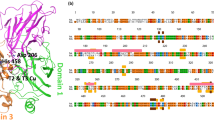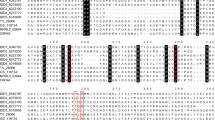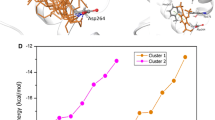Abstract
The filamentous fungus Trametes versicolor is a rich source of laccase (Tvlac). Laccases catalyze reactions that convert substituted phenol substrates into diverse derivatives through aromatic oxidation. We investigated methyl p-coumarate, methyl ferulate, and methyl caffeate biotransformation by Trametes versicolor ATCC 200801. Despite substrate similarity, the biotransformation reactions varied widely. Only methyl p-coumarate was converted into three derivatives. We isolated and identified the chemical structures of such derivatives by NMR and IR analysis. Hydroxylation, methylation, and hydrolysis were the main reactions resulting from the studied biotransformation. We also analyzed the interactions between Tvlac (PDB ID: 1GYC) and the three phenolic substrates by molecular docking simulations. The substituents in the phenol ring influenced substrate conformation and orientation in the Tvlac site. The biotransformation reaction selectivity correlated with the different binding energies to the Tvlac site. Our results demonstrated that docking studies successfully predict the biotransformation of cinnamic acid analogs by T. versicolor.






Similar content being viewed by others
References
Lenardão, E. J., Freitag, R. A., Dabdoub, M. J., Batista, A. C. F., & da C Silveira, C. (2003). “Green chemistry”: os 12 princípios da química verde e sua inserção nas atividades de ensino e pesquisa. Química Nova, 26(1), 123–129. https://doi.org/10.1590/S0100-40422003000100020.
Hai-Feng, Z., Guo-Qing, H., Jing, L., Hui, R., Qi-He, C., Qiang, Z., & Hong-Bo, Z. (2008). Production of gastrodin through biotransformation of p-2-hydroxybenzyl alcohol by cultured cells of Armillaria luteo-virens Sacc. Enzyme and Microbial Technology, 43, 25–30. https://doi.org/10.1016/j.enzmictec.2008.03.007.
Rivera-Hoyos, C. M., Morales-Alvarez, E. D., Pedroza-Rodríguez, A. M., Rodríguez-Vásquez, R., & Delgado-Boada, J. M. (2013). Fungal laccases. Fungal Biology Reviews, 27, 67–82. https://doi.org/10.1016/j.fbr.2013.07.001.
Margot, J., Bennati-Granier, C., Maillard, J., Blánquez, P., Barry, D. A., & Holliger, C. (2013). Bacterial versus fungal laccase: potential for micropollutant degradation. AMB Express, 3(1), 63. https://doi.org/10.1186/2191-0855-3-63.
Heinzkill, M., Bech, L., Halkier, T., Schneider, P., & Anke, T. (1998). Characterization of laccases and peroxidases from wood-rotting fungi (family Coprinaceae). Applied and Environmental Microbiology, 64, 1601–16056.
Caparrós-Ruiz, D., Fornalé, S., Civardi, L., Puigdomènech, P., & Rigau, J. (2006). Isolation and characterisation of a family of laccases in maize. Plant Science, 171(2), 217–225. https://doi.org/10.1016/j.plantsci.2006.03.007.
Ullah, M. A., Bedford, C. T., & Evans, C. S. (2000). Reactions of pentachlorophenol with laccase from Coriolus versicolor. Applied Microbiology and Biotechnology, 53(2), 230–234. https://doi.org/10.1007/s002530050013.
Abadulla, E., Tzanov, T., Costa, S., Robra, K.-H., Cavaco-Paulo, A., & Gubitz, G. M. (2000). Decolorization and detoxification of textile dyes with a laccase from Trametes hirsuta. Applied and Environmental Microbiology, 66(8), 3357–3362. https://doi.org/10.1128/AEM.66.8.3357-3362.2000.
Riva, S. (2006). Laccases: blue enzymes for green chemistry. Trends in Biotechnology, 24(5), 219–226. https://doi.org/10.1016/j.tibtech.2006.03.006.
Baldrian, P. (2006). Fungal laccases – occurrence and properties. FEMS Microbiology Reviews, 30(2), 215–242. https://doi.org/10.1111/j.1574-4976.2005.00010.x.
Wang, F., Hu, J.-H., Guo, C., & Liu, C.-Z. (2014). Enhanced laccase production by Trametes versicolor using corn steep liquor as both nitrogen source and inducer. Bioresource Technology, 166, 602–605. https://doi.org/10.1016/j.biortech.2014.05.068.
Iimura, Y., Sonoki, T., & Habe, H. (2018). Heterologous expression of Trametes versicolor laccase in Saccharomyces cerevisiae. Protein Expression and Purification, 141, 39–43. https://doi.org/10.1016/j.pep.2017.09.004.
Martínez-Sotres, C., Rutiaga-Quiñones, J. G., Herrera-Bucio, R., Gallo, M., & López-Albarrán, P. (2015). Molecular docking insights into the inhibition of laccase activity by medicarpin. Wood Science and Technology, 49(4), 857–868. https://doi.org/10.1007/s00226-015-0734-8.
Kameshwar, A. K. S., Barber, R., & Qin, W. (2018). Comparative modeling and molecular docking analysis of white, brown and soft rot fungal laccases using lignin model compounds for understanding the structural and functional properties of laccases. Journal of Molecular Graphics and Modelling, 79, 15–26. https://doi.org/10.1016/j.jmgm.2017.10.019.
Mikolasch, A., Matthies, A., Lalk, M., & Schauer, F. (2008). Laccase-induced C–-N coupling of substituted p-hydroquinones with p-aminobenzoic acid in comparison with known chemical routes. Applied Microbiology and Biotechnology, 80(3), 389–397. https://doi.org/10.1007/s00253-008-1595-y.
de Oliveira Silva, E., & Batista, R. (2017). Ferulic acid and naturally occurring compounds bearing a feruloyl moiety: a review on their structures, occurrence, and potential health benefits. Comprehensive Reviews in Food Science and Food Safety, 16, 580–616. https://doi.org/10.1111/1541-4337.12266.
Stoilova, I., Krastanov, A., & Stanchev, V. (2010). Properties of crude laccase from Trametes versicolor produced by solid-substrate fermentation. Advances in Bioscience and Biotechnology, 01, 208–215. https://doi.org/10.4236/abb.2010.13029.
Witayakran, S., & Ragauskas, A. J. (2009). Synthetic applications of laccase in Green Chemistry. Advanced Synthesis & Catalysis, 351, 1187–1209. https://doi.org/10.1002/adsc.200800775.
Trejo-Hernandez, M. R., Lopez-Munguia, A., & Quintero Ramirez, R. (2001). Residual compost of Agaricus bisporus as a source of crude laccase for enzymic oxidation of phenolic compounds. Process Biochemistry, 36, 635–639. https://doi.org/10.1016/S0032-9592(00)00257-0.
Falconnier, B., Lapierre, C., Lesage-Meessen, L., Yonnet, G., Brunerie, P., Colonna-Ceccaldi, B., & Asther, M. (1994). Vanillin as a product of ferulic acid biotransformation by the white-rot fungus Pycnoporus cinnabarinus I-937: identification of metabolic pathways. Journal of Biotechnology, 37, 123–132. https://doi.org/10.1016/0168-1656(94)90003-5.
Boaventura, M. A. D., Lopes, R. F. A. P., & Takahashi, J. A. (2004). Microorganisms as tools in modern chemistry: the biotransformation of 3-indolylacetonitrile and tryptamine by fungi. Brazilian Journal of Microbiology, 35, 345–347.
Garzón-Posse, F., Becerra-Figueroa, L., Hernández-Arias, J., & Gamba-Sánchez, D. (2018). Whole cells as biocatalysts in organic transformations. Molecules, 23(6), 1265. https://doi.org/10.3390/molecules23061265.
de Carvalho, C. C. C. R. (2017). Whole cell biocatalysts: essential workers from Nature to the industry. Microbial Biotechnology, 10(2), 250–263. https://doi.org/10.1111/1751-7915.12363.
Höring, P., Rothschild-Mancinelli, K., Sharma, N. D., Boyd, D. R., & Allen, C. C. R. (2016). Oxidative biotransformations of phenol substrates catalysed by toluene dioxygenase: a molecular docking study. Journal of Molecular Catalysis B: Enzymatic, 134, 396–406. https://doi.org/10.1016/j.molcatb.2016.10.013.
Awasthi, M., Jaiswal, N., Singh, S., Pandey, V. P., & Dwivedi, U. N. (2015). Molecular docking and dynamics simulation analyses unraveling the differential enzymatic catalysis by plant and fungal laccases with respect to lignin biosynthesis and degradation. Journal of Biomolecular Structure and Dynamics, 33, 1835–1849. https://doi.org/10.1080/07391102.2014.975282.
Mo, D., Zeng, G., Yuan, X., Chen, M., Hu, L., Li, H., & Cheng, M. (2018). Molecular docking simulation on the interactions of laccase from Trametes versicolor with nonylphenol and octylphenol isomers. Bioprocess and Biosystems Engineering, 41(3), 331–343. https://doi.org/10.1007/s00449-017-1866-z.
Hongyan, L., Zexiong, Z., Shiwei, X., He, X., Yinian, Z., Haiyun, L., & Zhongsheng, Y. (2019). Study on transformation and degradation of bisphenol A by Trametes versicolor laccase and simulation of molecular docking. Chemosphere, 224, 743–750. https://doi.org/10.1016/j.chemosphere.2019.02.143.
Pieters, L., Van Dyck, S., Gao, M., Bai, R., Hamel, E., Vlietinck, A., & Lemière, G. (1999). Synthesis and biological evaluation of dihydrobenzofuran lignans and related compounds as potential antitumor agents that inhibit tubulin polymerization. Journal of Medicinal Chemistry, 42, 5475–5481. https://doi.org/10.1021/jm990251m.
Morris, G. M., Huey, R., Lindstrom, W., Sanner, M. F., Belew, R. K., Goodsell, D. S., & Olson, A. J. (2009). AutoDock4 and AutoDockTools4: automated docking with selective receptor flexibility. Journal of Computational Chemistry, 30(16), 2785–2791. https://doi.org/10.1002/jcc.21256.
Rodrigues, R. P., Mantoani, S. P., de Almeida, J. R., Pinsetta, F. R., Semighini, E. P., da Silva, V. B., & Silva, C. H. T. P. (2012). Virtual screening strategies in drug design. Revista Virtual de Química, 4, 739–776. https://doi.org/10.5935/1984-6835.20120055.
da Paixão, V. G., & da R Pita, S. S. (2019). In silico identification and evaluation of new Trypanosoma cruzi trypanothione reductase (TcTR) inhibitors obtained from natural products database of the Bahia semi-arid region (NatProDB). Computational Biology and Chemistry, 79, 36–47. https://doi.org/10.1016/j.compbiolchem.2019.01.009.
Huey, R., Morris, G. M., Olson, A. J., & Goodsell, D. S. (2007). A semiempirical free energy force field with charge-based desolvation. Journal of Computational Chemistry, 28(6), 1145–1152. https://doi.org/10.1002/jcc.20634.
Gasteiger, J., & Marsili, M. (1980). Iterative partial equalization of orbital electronegativity-a rapid access to atomic charges. Tetrahedron, 36, 3219–3228. https://doi.org/10.1016/0040-4020(80)80168-2.
Montanari, C. (2011). Química Medicinal: métodos e fundamentos em planejamento de fármacos (1st ed.). São Paulo: EDUSP.
Salameh, D., Brandam, C., Medawar, W., Lteif, R., & Strehaiano, P. (2008). Highlight on the problems generated by p-coumaric acid analysis in wine fermentations. Food Chemistry, 107, 1661–1667. https://doi.org/10.1016/j.foodchem.2007.09.052.
Foti, M. C., Daquino, C., & Geraci, C. (2004). Electron-transfer reaction of cinnamic acids and their methyl esters with the DPPH radical in alcoholic solutions. The Journal of Organic Chemistry, 69, 2309–2314. https://doi.org/10.1021/jo035758q.
Li, Y., & Hesse, M. (2003). The syntheses of cyclic spermine alkaloids: analogues of buchnerine and budmunchiamine C. Helvetica Chimica Acta, 86, 310–323. https://doi.org/10.1002/hlca.200390033.
Du, X., Li, Y., Xia, Y. L., Ai, S. M., Liang, J., Sang, P., & Liu, S. Q. (2016). Insights into protein–ligand interactions: mechanisms, models, and methods. International Journal of Molecular Sciences, 17(2), 1–34. https://doi.org/10.3390/ijms17020144.
Dellafiora, L., Galaverna, G., Reverberi, M., & Dall’Asta, C. (2017). Degradation of aflatoxins by means of laccases from Trametes versicolor: an in silico insight. Toxins, 9(1), 17. https://doi.org/10.3390/toxins9010017.
Schrödinger, L. L. C. (2018). The PyMOL molecular graphics system. New York, USA.
Acknowledgments
JCSC thanks FAPESB for his scholarship.
Funding
This work was supported by the Brazilian National Council for Scientific and Technological Development (CNPq), Brazilian Coordination for Improvement of Personnel Higher Education (CAPES), and Bahia Research Foundation (FAPESB, grant numbers JCB-0039/2013 and RED-008/2013).
Author information
Authors and Affiliations
Corresponding author
Ethics declarations
Conflict of interest
The authors declare that they have no conflict of interest.
Ethical approval
This article does not contain any studies with human participants or animals performed by any of the authors.
Additional information
Publisher’s Note
Springer Nature remains neutral with regard to jurisdictional claims in published maps and institutional affiliations.
Electronic supplementary material
ESM 1
(DOCX 527 kb)
Rights and permissions
About this article
Cite this article
Conceição, J.C.S., Dias, H.J., Peralva, C.M.S. et al. Phenolic Compound Biotransformation by Trametes versicolor ATCC 200801 and Molecular Docking Studies. Appl Biochem Biotechnol 190, 1498–1511 (2020). https://doi.org/10.1007/s12010-019-03191-y
Received:
Accepted:
Published:
Issue Date:
DOI: https://doi.org/10.1007/s12010-019-03191-y




